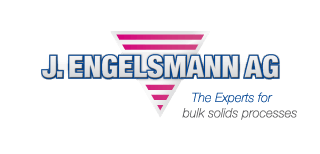Screening technology for professionals – by professionals
Whether it’s a gentle screening process, hygienic machine use or the simple operability and cleanability of the screening technology used that matters the most to you – Engelsmann has the ideal screening solution for your needs.
Screening technology suited to the screening process
Engelsmann offers screening machines for all standard screening processes. Click on the buttons to find out more about the right screening machine for your requirements.
Screening machines for coarse screening Screening machines for fine screening
Screening machines for deagglomeration
Screening technology based on the screen movement
With our long-stroke screening machines, the entire screen trough oscillates. The product is very gently screened thanks to the horizontal movements. For this reason, long-stroke screening machines are best suited to delicate and easily breakable bulk solids.
The vibration-based screen movement is generated by vibration motors which move the screens both horizontally and vertically. Our vibration screening machines work very efficiently and achieve a high throughput rate despite having a relatively low surface area.
With centrifugal screening machines, the material is moved through a cylindrical screening basket with the help of rotors. Centrifugal screening machines are perfect for straining and deagglomeration, but they can also achieve very good results with caking and fatty products.
Screening technology is one of the oldest and most widely used technologies for processing bulk solids. Broadly speaking, a screening machine is a device which can separate solids according to the particle size criteria.
A non-homogeneous solid mixture with different particle sizes can be separated into at least two fractions which vary significantly from each other in terms of minimum and maximum particle sizes when strained by the screen. Separation is carried out by a sieve which is done with either a perforated metal plate or mesh.
According to the existing particle range and desired screening results, the gaps are finer or coarser. Particles which are larger than the gaps remain on the screen as coarse or oversized particles whereas the smaller particles fall through the meshes below as undersized or fine particles. Mesh-sized particles are product particles which are the same size as the gaps. These particles get stuck in the gaps during the screening process and clog the screen. Cleaning the sieve regularly is a very important requirement for the screening machine to work effectively.
An important jumping off point when choosing the right screening machine is its function in the production process. Engelsmann essentially differentiates between six different types of screenings.
Protective screening
Protective Screening is carried out to separate foreign particles which have inadvertently ended up in the product.
Screening machines for protective screening
Coarse / Oversize grain screening
Sifting off coarse and oversized particles involves separating product particles that are outside of the required particle size spectrum. They will be sieved and either included back into the production process or disposed of.
Screening machines for coarse screening
Fine screening
This type of screening is aimed at separating product particles and dust.
Screening machines for fine screening
Grading
Grading screenings are multi-stage screenings where a non-homogeneous solid mixture is separated into at least two fractions, whereby each fraction corresponds to a certain predefined particle range.
Screening machines for grading
Deagglomerating
When deagglomerating, agglomerates in the material which has formed during production are mechanically dissolved in the sieve so that they can pass through the mesh.
Dissolving agglomerated bulk solids
Screening machines for de-agglomeration
Straining
Straining sieves are widely used when handling pasty bulk solids that contain unwanted agglomerates or lumps. Rotating strainers help to pass those parts through the sieve mesh so they dissolve completely.
A screening machine is made from a round or rectangular housing in which the sieve is located – the core of every industrial sieve. The screening material is loaded into the screening machine through an inlet on the housing. To ensure that the screening process runs as quickly and efficiently as possible, the housing must be set in motion with the sieve. In practice, this happens in three different ways: with vibration, in a circular or linear swinging motion or through rotation. Correspondingly, there is a distinction in practice between vibrating screening machines, stroke or oscillating screening machines and centrifugal screening machines. Here, Engelsmann has appropriate solutions for all areas.
Vibration and stroking screening machines are equipped with flat, horizontal sieves and apart from movement, they use gravity in particular for screening. Centrifugal screening machines, on the other hand, have a cylindrical sieve basket which has a rotating shaft with hammers which distributes the material evenly on the sieve’s surface. In this case the product is screened by centrifugal forces.
The screening housing is, as a rule, mounted on a frame and either forms a solid unit like in the centrifugal screening machines or is flexibly mounted with the aid of springs like in the vibrating screening machines so that the screening housing can move and vibrate freely inside the frame. The oscillation or vibration amplitude is controlled with help from vibrating motors or flywheel engines. The kinetic energy causes the smaller particles to pass through the mesh of the sieve while the coarse particles left on the mesh are channeled out of the machine through the screening outflow. According to the amount of fraction or sieve decks installed there are one or more out-flow ports on a screening machine.
Many bulk solids can clog the mesh during the screening process. To prevent the mesh from being afflicted and the screening machine from losing its throughput rate it is vital in many cases that the mesh is cleaned regularly. Many sieves have an integrated cleaning system. Engelsmann offers ball, triangle and ultrasound cleaning systems in particular.
Ball cleaning system
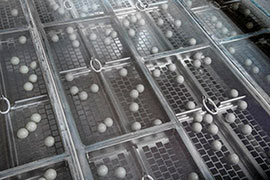 Rubber balls work in the lower area of the sieve and bounce against the mesh and from underneath thanks to the shaking movement of the screening machine and therefore loosen the particles which are clogging the mesh.
Rubber balls work in the lower area of the sieve and bounce against the mesh and from underneath thanks to the shaking movement of the screening machine and therefore loosen the particles which are clogging the mesh.
Triangle cleaning system
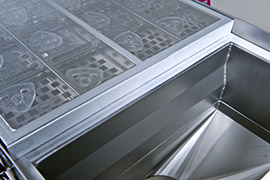 The triangle cleaning process works according to the same principle as the ball cleaning system. Instead of balls, here, flat, triangular pieces of plastic are used which are fitted with knobs or short bristles according to the screening product and which hit against the mesh from below or pierce through the clogged screen mesh.
The triangle cleaning process works according to the same principle as the ball cleaning system. Instead of balls, here, flat, triangular pieces of plastic are used which are fitted with knobs or short bristles according to the screening product and which hit against the mesh from below or pierce through the clogged screen mesh.
Ultrasound cleaning system
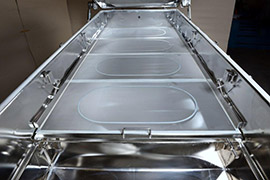 In the ultrasound cleaning, on the other hand, sound waves with vibrations at extremely low amplitudes are put through the mesh. This kind of cleaning is designed for finely powdered materials under 500µm.
In the ultrasound cleaning, on the other hand, sound waves with vibrations at extremely low amplitudes are put through the mesh. This kind of cleaning is designed for finely powdered materials under 500µm.
Impact cleaning system
Particularly difficult products such as fatty flaked nuts push even current cleaning systems to their limits. For one, the flakes get properly wedged in the meshes and stick together, and they are so delicate that a ball or triangle cleaning system turns them into a pulp which then cannot be used in the end product.
For this, Engelsmann has developed a special impact system with the linear oscillating screening machine “JEL Freischwinger”. This system works by making the momentum drive and screen trough work together: The trough hangs freely on several plastic spring elements in the frame and made to vibrate horizontally by the drive. There are rubber impact connectors on the trough and frame which bounce off each other without damaging the machine or the product. Through this impact momentum, even the most stubborn particles are loosened immediately.
In order to find the right industrial sieve for your application, there are several selection criteria that need to be considered.
Material
The most important factors when choosing and constructing a screening machine are the screening material and its properties. Only if a detailed description of the product which is going to be screened can be given beforehand, then a precisely fitting appropriate screening solution can be constructed. Important parameters when describing the material’s properties are e.g. Bulk weight and the dumping angle, flow properties, moisture content, temperature or whether the product is abrasive, caking or fatty.
Type of screening
Precise knowledge of the material’s properties and the task generally allows conclusions to be drawn about the appropriate type of screening machine and its construction (materials, functions, etc.).
The actual process reliability or the suitability of the screening machine and procedure can be checked as part of the screening tests. Even with difficult products and complicated production procedures, the tests make it possible to fine tune and optimize the screening process by adjusting the machine configurations if necessary.
Screening Surface
One last important aspect is choosing the correct sieving surface. It also essentially depends on the material’s properties such as the flowability. If the optimal mesh width for the particle range obtained is found, then the sieving surface should be chosen so that the throughput capacity desired by the operator is achieved without the screening material building up too high over the sieve when loading. There is a risk here that the product will be fed out of the machine through the screening outflow without passing through the mesh. And here too, the know-how of the screen manufacturer is in demand: If the surface of the sieve is laid out too large due to inexperience, part of the mesh remains practically unused. Too much sieve surface inevitably leads to unnecessary costs or inefficient screening solutions.
Cleaning
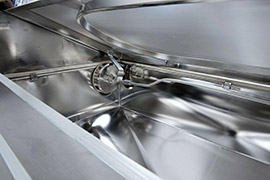 Cleaning the industrial sieves leads to high costs and expenditure of time or periods of machine downtime when they are cleaned as frequently as appropriate. When acquiring screening machines, you must ensure that the components are quick and easy to clean and most importantly do not leave a residue.
Cleaning the industrial sieves leads to high costs and expenditure of time or periods of machine downtime when they are cleaned as frequently as appropriate. When acquiring screening machines, you must ensure that the components are quick and easy to clean and most importantly do not leave a residue.
Product residues which are not completely removed despite being cleaned can rot and lead to germs growing in the product. If various products are produced in the same facilities this residue can also lead to cross contamination at the cost of the quality and purity of the end product. All of the parts of the screening machine which come into contact with the product such as the internal housing, the sieve as well as the inlets and outflows should not have any constructional dead space where the finest product particles could settle.
Even welded seams and corners should be rounded off so that they do not form a sharp angle. All surfaces must be as flat as possible and free from cracks. Here stainless steel is recognized as the industry standard with the appropriate surface finishing (e.g. mirror polishing) and the lowest possible roughness depth (< 0.8μm). Moreover, stainless steel has a higher resistance to chemical cleaning agents or abrasive screening products which assail the surface.
The design of a round screening machine offers benefits, especially for applications where it is essential to thoroughly clean the screening machine. The round screen housing is free of dead space and as a result is particularly simple to clean thoroughly. Engelsmann provides the vibrating round screening machine JEL VibRS for this purpose. Rectangular and centrifugal screening machines are also very good for use in applications with high hygiene requirements so long as they have been constructed in hygienic design – with proportionally increased radii, consistently smooth surfaces, and no dead spaces. The rectangular screening machine JEL Konti, for example, comes with increased radii, consistently smooth surfaces, and no dead spaces, and so conforms to even the highest hygiene requirements – despite its rectangular design.
To reduce the machine downtime to a minimum when cleaning the facilities, it is naturally an advantage if the screening machine can be cleaned thoroughly directly at the usage site without having to dissemble the machine (keyword CIP). But even in cases where the cleaning takes place in a different space and the screening machine has to be dissembled and put back together again, Engelsmann provides modular screening machine ranges such as JEL VibSpeed, and JEL Konti where this can be done quickly and in a user friendly manner.
Operation and maintenance
 Screening technology is among the simplest yet most important system components in many production processes and make a vital contribution to the safety and quality of the products. For that reason, they must always work reliably – and be as efficient and economical as possible. An essential aspect in the operation and maintenance is changing the sieves, if it is necessary as part of production to switch to a different mesh width or swapping the sieve due to a fault in the sieving mesh.
Screening technology is among the simplest yet most important system components in many production processes and make a vital contribution to the safety and quality of the products. For that reason, they must always work reliably – and be as efficient and economical as possible. An essential aspect in the operation and maintenance is changing the sieves, if it is necessary as part of production to switch to a different mesh width or swapping the sieve due to a fault in the sieving mesh.
With many sieves, this is only possible when the screening machine is at least partially disassembled. As with cleaning, machine downtime is the main issue. Operators should be aware that the sieve ideally should be changed without the need for tools and can be done in a few hand movements. The same of course applies to swapping other faulty components – here, good access to all parts and the machine being easy to disassemble also has a positive effect on the machine downtime.
When in use, the operator can quickly adjust other screening settings to the current screening task such as the inclination of the screening deck or the oscillation or vibration amplitude of the drive/motor.
 Engelsmann offers a perfect solution to store screen inserts: special storage cabinets into which the screen inserts can be securely slotted complete with the respective integrated cleaning system. The cabinet can be sealed dust-tight with the help of a robust door, clamping devices and a continuous seal. Since the operator also screens hot products, the door was designed with ventilation slots so that heated screen inserts can release steam unhindered without too much moisture building up in the storage cabinet itself.
Engelsmann offers a perfect solution to store screen inserts: special storage cabinets into which the screen inserts can be securely slotted complete with the respective integrated cleaning system. The cabinet can be sealed dust-tight with the help of a robust door, clamping devices and a continuous seal. Since the operator also screens hot products, the door was designed with ventilation slots so that heated screen inserts can release steam unhindered without too much moisture building up in the storage cabinet itself.
Alongside these technical production aspects, this screen cabinet has an additional benefit in that it provides an ideal transport container if the screen inserts need to be transported internally to screening machines or need to be sent externally for re-covering. When required, the cabinet can easily be picked up by a forklift or, for the mobile variant, can be moved on castors.

